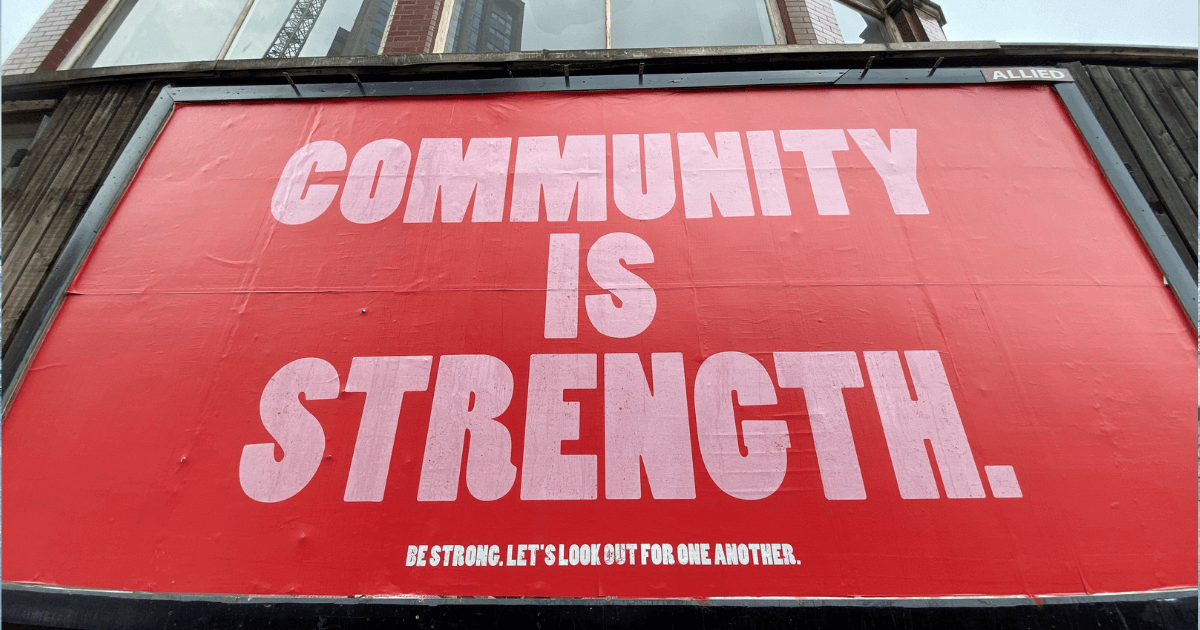This article originates from a talk at the Chief Marketing Officer Summit in New York, 2023.
Community building, both in the realms of food and fitness, is a fascinating and multifaceted challenge. It's about much more than just offering a product or service; it's about creating spaces - physical and digital - that resonate with and engage people at a deeper level.
I'm Steph So, Head of Digital Experiences at Shake Shack, and I had the privilege of discussing community building with Zipporah Allen, the Chief Business Officer at Strava.
In this article, we delve into the nuances of expanding our brands from niche to mass markets, the integration of digital and physical experiences, and how the pandemic has reshaped consumer interactions.
Join me as I unfold the lessons and strategies from this dialogue, offering a glimpse into the art of community building in today's fast-paced world.

Expanding from niche to mass market
In my conversation with Zipporah, we touched upon a crucial topic in the growth of any brand: transitioning from a niche market to a mass audience. This is particularly relevant to Zipporah's journey with Strava and resonates with my experiences at Shake Shack as well.
Strava's evolution
Zipporah, with her rich background in the food industry, brought a unique perspective to Strava. She compared her experience at mass brands like Taco Bell, Pizza Hut, and McDonald's with the niche nature of Strava. Initially, Strava catered primarily to committed athletes - marathon runners, ultra-marathoners, and long-distance cyclists. The challenge was to evolve the platform from this niche focus to appeal to a broader audience.
An interesting insight Zipporah shared was about walking, which, though often overlooked as a sport, ranks as the third most popular activity on Strava. This revelation led to Strava broadening its appeal from cyclists and runners to include walkers, making the platform more accessible.
She illustrated this with an event in New York for Women's History Month and International Women's Day, focusing on the 'hot girl walk' phenomenon, which started on TikTok. This event not only celebrated walking as an activity but also contributed to a charitable cause, helping to shift Strava's image from an elite athlete's platform to a more inclusive community.
Shake Shack's approach to community and expansion
Shake Shack faced similar challenges. As we expanded to the West Coast, a region dominated by In-N-Out, we were conscious of not being perceived as too niche or controversial. Our goal was to be seen as a community hub - a place for celebrating little league wins or the end of a hot girl walk.
To maintain our image as a community-centric brand, even as we expand, we've employed regional marketing managers to engage in community events and ensure local relevance. This approach helps us stay connected to our customers' lives and their communities, making Shake Shack a part of their everyday celebrations and gatherings.
Discovering the overlap between Strava and Shake Shack audiences
In our dialogue, Zipporah and I stumbled upon an intriguing overlap between the Strava and Shake Shack audiences. This intersection, though not immediately obvious, highlights how both brands cater to a similar demographic with shared values and interests.
I described our target audience at Shake Shack as 'upbeat upgraders' - people who are willing to pay a bit more for high-quality experiences. Interestingly, this group highly values fun and sports, aligning surprisingly well with the active lifestyle promoted by Strava. This discovery led us to explore unique marketing initiatives that resonate with this audience.
Inspired by the popularity of pickleball and its alignment with our brand values, Shake Shack embarked on a series of local events centered around this sport. We started with the Shake Shack Pickleball Club, featuring food, coaches, and a fun environment. The success of these events was overwhelming, leading us to plan a nationwide tour.
This year, we are expanding the Shake Shack Pickleball Club to 12-13 cities. The key to this initiative's success is its alignment with the celebratory and community-focused nature of our brand. We’re even building a microsite for the Shake Shack Pickleball Club, showcasing our commitment to engaging our audience in new and exciting ways.
Zipporah mentioned that pickleball, like many other activities, can be tracked on Strava. This capability is a testament to Strava's adaptability and its commitment to encompassing a wide range of activities within its community. It also opens up opportunities for collaboration between Strava and Shake Shack, especially in terms of community engagement and promoting an active lifestyle.
The pandemic's impact on consumer behavior
In our discussion, Zipporah and I explored how the unprecedented times of the pandemic influenced consumer behavior and preferences, particularly in the context of our respective industries - fitness and food.
The pandemic's boost to Strava's community
Zipporah shared how Strava experienced significant growth during the pandemic. With restrictions on indoor gatherings and gym closures, people turned to outdoor activities, which is where Strava thrives.
The platform not only offered a way to track outdoor activities but also became a vital tool for maintaining community and connection during times of isolation. This period highlighted the importance of virtual communities in fostering real-life interactions and connections, regardless of geographical barriers.
Zipporah also discussed how Strava's platform became a space for social justice conversations and community building among diverse groups. She highlighted examples like Alison Désir's Harlem Run Club and Haroon Mota's Muslim Hikers in the UK, which have used Strava to create inclusive and safe spaces for their communities. This aspect of community building, enhanced during the pandemic, remains a critical and enduring part of Strava's identity.
Shake Shack's digital transformation and focus on experience
Relating to Strava's experiences, I shared how the restaurant industry, particularly Shake Shack, underwent a rapid digital transformation during the pandemic. The shift to a predominantly digital business model was a significant change, and now, as we normalize, the digital component remains a crucial aspect of our business.
However, the return to in-person experiences has led us to focus on enhancing the quality of these interactions. We're constantly thinking about how to make the in-person Shake Shack experience memorable and worth choosing over a simple DoorDash order.
This involves considering everything from the cleanliness of our restaurants to the ambiance of our patios. Our new initiatives like catering boxes and easy group ordering options are responses to the evolving needs and preferences of our customers.

Q&A
What was your transition like from Chief Marketing Officer (CMO) to Chief Business Officer (CBO)?
Zipporah explained that her background was predominantly in brand and product marketing within the Quick Service Restaurant (QSR) industry, including significant roles at McDonald's, Pizza Hut, and Taco Bell. She highlighted the evolving nature of the CMO role, especially in the technology sector. Traditionally, CMOs have been focused on growth in terms of revenue, audience, and customer traffic. However, in recent years, this role has expanded to encompass a more holistic view of the business funnel.
As the CBO at Strava, Zipporah's responsibilities extend beyond traditional marketing. Her role now includes not just customer acquisition but also retention, engagement, and conversion, especially considering Strava's freemium business model and its subscription element. The CBO role, as Zipporah described it, consolidates all business growth functions into a single organization, encompassing areas such as product development, engineering, analytics, and design.
This transition underscores a broader shift in business leadership roles, where boundaries between marketing, product development, and overall business strategy are becoming increasingly blurred. The role of a CBO is more integrated and comprehensive, requiring a deep understanding of both the consumer and the product, and how these elements interact to drive business growth.
Do you find yourself competing internally between the digital experience and the in person experience?
Responding to this inquiry, I reflected on my experiences in different industries and how they compare to the challenges faced at Shake Shack. In retail, particularly during my tenure at Ralph Lauren, the digital and physical experiences often felt distinct, with different channels operating somewhat independently. However, in the restaurant industry, and especially at Shake Shack, this division is less pronounced due to the inherent connection between digital orders and physical locations.
At Shake Shack, we've implemented several organizational strategies to ensure a seamless integration of digital and physical experiences. One key initiative is the establishment of a digital operations team within the broader operations division. This team focuses on enabling our restaurants to manage digital platforms effectively, ensuring they are equipped to handle both in-store and online orders simultaneously.
We strive to avoid scenarios where restaurant operators feel compelled to prioritize walk-in customers over digital orders. Understanding that a customer ordering via DoorDash or our app is equally valuable and likely just as loyal as a dine-in customer is crucial. Therefore, we train our staff to see all customers, whether physical or digital, as integral to our business.
A significant aspect of this approach involves considering the customer's journey from the moment they place a digital order to when they collect their food. It's not just about making the ordering process easy but also ensuring that the pickup experience is convenient and pleasant. This means strategically designing the restaurant layout and training staff to provide quick and friendly service to all customers, regardless of how they choose to order.
The way we've structured our teams and the culture we've fostered at Shake Shack are pivotal in maintaining this balance. We've created a synergy between our digital platforms and physical restaurants, recognizing that the success of one directly impacts the other. This holistic approach ensures that we deliver a consistently high-quality experience, whether our customers are dining in or ordering to go.
What are the challenges and opportunities of maintaining a brand's unique identity, especially in the digital space?
I've had the opportunity to work closely with Danny Meyer, our President of the Board. Although Danny doesn't handle day-to-day operations, his influence and philosophy deeply permeate our approach, especially in translating our brand ethos to digital platforms.
Danny has always emphasized the importance of replicating the warm, welcoming atmosphere of our physical locations in our digital interactions. He challenges us to ensure that customers feel the same sense of hospitality on our app and website as they would walking into Union Square Cafe. This has been a guiding principle in our digital strategy, pushing us to think beyond efficiency and functionality to infuse our digital presence with the unique Shake Shack personality.
This focus means sometimes deviating from the standard 'best practices' in digital design. Instead of simply aiming for the least clicks to checkout, we strive to add elements that reflect our brand's character, such as playful animations, engaging content, and interesting tidbits about our products. This approach sets us apart in a crowded digital space and helps maintain the essence of Shake Shack's brand identity.
Zipporah echoed similar sentiments, drawing on her experience in the QSR industry. She highlighted how Taco Bell's distinct brand was carried through in their digital initiatives, such as the innovative taco subscription on their app. This kind of creativity in digital offerings is crucial in preserving a brand's uniqueness and ensuring a memorable customer experience.
Both Zipporah and I agree that the moment when the customer, the team member, and the product converge is critical. Ensuring a high-quality, friendly interaction at this point is challenging but can significantly impact the overall customer experience. It's about bringing the brand's distinctiveness to life, not just in the digital realm but in every customer interaction.
How have you been successful consistently integrating a brand's identity throughout every customer interaction in your organizations?
Zipporah acknowledged that Strava is at the early stages of distinctively defining its brand. Historically, Strava had a male-dominated, performance-driven image, which they are actively working to change.
An example Zipporah shared was the modification of Strava's App Store description, which previously positioned the app primarily for runners and cyclists. Recognizing this as a potential barrier for non-traditional Strava activities like walking or Pilates, they altered the description to be more inclusive, resulting in a significant increase in conversion rates.
Zipporah emphasized the importance of examining the customer journey for potential barriers and making adjustments to ensure inclusivity and welcoming vibes. She also highlighted the role of community builders on Strava and the company's careful approach to associating with individuals and events that align with their brand values, particularly regarding diversity and inclusivity.
I added to the discussion by focusing on an often-overlooked aspect of branding: post-service engagement and service recovery. At Shake Shack, we place a high emphasis on how customers feel, especially if their experience didn't meet expectations. This approach, deeply rooted in Danny Meyer's philosophy of enlightened hospitality, is about going beyond just rectifying a mistake. It involves ensuring that customers are not only compensated for any shortcomings but are also encouraged to return for a more positive experience.
In the digital realm, this translates to not just compensating for a missing item in an order but ensuring the customer feels valued and eager to revisit. Emulating successful ecommerce service recovery experiences is a key focus for us at Shake Shack as we strive to maintain our brand ethos across all digital interactions.
Community high on your priority list for 2024? Don't miss the opportunity to share ideas with an awesome community of marketing leaders at the CMO Summit: New York on March 20th.




